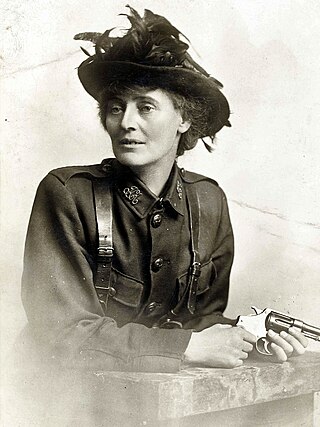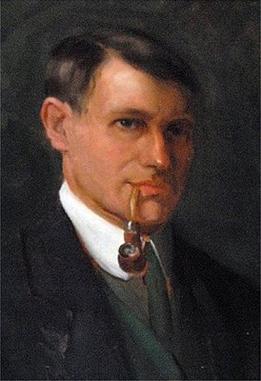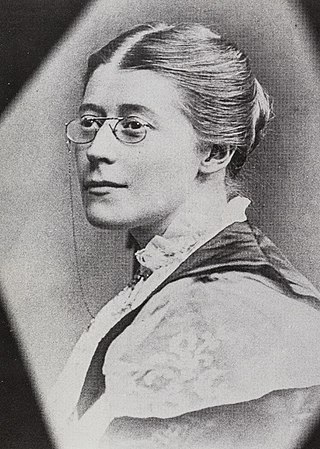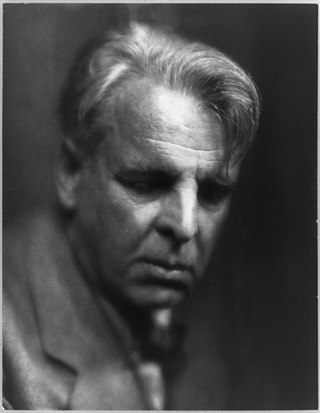Related Research Articles

William Butler Yeats was an Irish poet, dramatist and writer, and one of the foremost figures of 20th-century literature. He was a driving force behind the Irish Literary Revival, and along with Lady Gregory founded the Abbey Theatre, serving as its chief during its early years. He was awarded the 1923 Nobel Prize in Literature, and later served two terms as a Senator of the Irish Free State.

Constance Georgine Markievicz, also known as Countess Markievicz and Madame Markievicz, was an Irish politician, revolutionary, nationalist, suffragist, socialist, and the first woman elected to the Westminster Parliament. She was elected Minister for Labour in the First Dáil, becoming the second female cabinet minister in Europe. She served as a Teachta Dála for the Dublin South constituency from 1921 to 1922 and 1923 to 1927. She was a Member of Parliament (MP) for Dublin St Patrick's from 1918 to 1922.
"The Second Coming" is a poem written by Irish poet W. B. Yeats in 1919, first printed in The Dial in November 1920 and included in his 1921 collection of verses Michael Robartes and the Dancer. The poem uses Christian imagery regarding the Apocalypse and Second Coming to describe allegorically the atmosphere of post-war Europe. It is considered a major work of modernist poetry and has been reprinted in several collections, including The Norton Anthology of Modern Poetry.

Elizabeth Corbet Yeats, known as Lolly, was an Irish educator and publisher. She worked as an art teacher and published several books on art, and was a founder of Dun Emer Press which published several works by her brother W. B. Yeats. She was the first commercial printer in Ireland to work exclusively with hand presses.
The Cuala Press was an Irish private press set up in 1908 by Elizabeth Yeats with support from her brother William Butler Yeats that played an important role in the Celtic Revival of the early 20th century. Originally Dun Emer Press, from 1908 until the late 1940s it functioned as Cuala Press, publicising the works of such writers as Yeats, Lady Gregory, Colum, Synge, and Gogarty.

The Dun Emer Press was an Irish private press founded in 1902 by Evelyn Gleeson, Elizabeth Yeats and her brother William Butler Yeats, part of the Celtic Revival. It was named after the legendary Emer and evolved into the Cuala Press.

Eva Selina Laura Gore-Booth was an Irish poet, theologian, and dramatist, and a committed suffragist, social worker and labour activist. She was born at Lissadell House, County Sligo, the younger sister of Constance Gore-Booth, later known as the Countess Markievicz.
The Winding Stair is a volume of poems by Irish poet W. B. Yeats, published in 1933. It was the next new volume after 1928's The Tower. The title poem was originally published in 1929 by Fountain Press in a signed limited edition, which is exceedingly rare.

"The Stolen Child" is an 1889 poem by William Butler Yeats, published in The Wanderings of Oisin and Other Poems.
"Adam's Curse" is a poem written by William Butler Yeats. In the poem, Yeats describes the difficulty of creating something beautiful. The title alludes to the Book of Genesis, evoking the fall of man and the separation of work and pleasure. Yeats originally included the poem in the volume In the Seven Woods, published in 1903.

Casimir Dunin Markievicz, known as Count Markievicz, was a Polish playwright, theatre director, and painter, and the husband of the Irish revolutionary Constance Markievicz.

Easter, 1916 is a poem by W. B. Yeats describing the poet's torn emotions regarding the events of the Easter Rising staged in Ireland against British rule on Easter Monday, April 24, 1916. The rebellion was unsuccessful, and most of the Irish republican leaders involved were executed. The poem was written between May and September 1916, printed privately, 25 copies, and appeared in magazines in 1920 but first published in 1920 in the collection Michael Robartes and the Dancer.

"A Prayer for My Daughter" is a poem by William Butler Yeats written in 1919 and published in 1921 as part of Yeats' collection Michael Robartes and the Dancer. It is written to Anne, his daughter with Georgie Hyde-Lees, whom Yeats married after his last marriage proposal to Maud Gonne was rejected in 1916. Yeats composed the poem while staying in a tower at Thoor Ballylee during the Anglo-Irish War, two days after Anne's birth on 26 February 1919. The poem reflects Yeats's complicated views on Irish Nationalism, sexuality, and is considered an important work of Modernist poetry.

Lissadell House is a neo-classical Greek revivalist style country house in County Sligo, Ireland.

Esther Roper was a suffragist and social justice campaigner who fought for equal employment and voting rights for working-class women.
"Under Ben Bulben" is a poem written by Irish poet W. B. Yeats.
"The Wild Swans at Coole" is a lyric poem by the Irish poet William Butler Yeats (1865–1939). Written between 1916 and early 1917, the poem was first published in the June 1917 issue of the Little Review, and became the title poem in the Yeats's 1917 and 1919 collections The Wild Swans at Coole.

Sir Henry William Gore-Booth, 5th Baronet, was a notable Arctic explorer, adventurer and landowner from Lissadell House, Sligo, Ireland.

Blood and the Moon is a poem by Irish poet William Butler Yeats written in 1927. It was first published in the Spring 1928 issue of The Exile and then in the collection The Winding Stair in 1929, before being reprinted in The Winding Stair and Other Poems in 1933. Yeats composed the poem in response to the 1927 assassination of Kevin O'Higgins, the Vice-President of the Free State, whom Yeats had known personally. The poem contains many themes common in Yeats's poems from the 1920s including the "tower", a reference to Thoor Ballylee, which had been the title of a collection of works printed the year before "Blood and the Moon" was published, as well as the "gyre" which had been a major focus of his 1920 poem "The Second Coming".
"To the Rose upon the Rood of Time" is poem by W. B. Yeats that was published in The Rose in 1893. The poem is one of many early Yeatsian lyrical poems which utilize the symbol of the rose. The poem consists of twelve rhyming couplets in iambic pentameter.
References
- ↑ Conner, Lester I. (1999). A Yeats Dictionary: Persons and Places in the Poetry of William Butler Yeats (1. paperback ed.). Syracuse, NY: Syracuse University Press. p. 74. ISBN 0-8156-2769-6.
- 1 2 3 Brett, R.L. (1997). Faith and Doubt. James Clarke & Co. p. 171. ISBN 978-0-227-67941-8 . Retrieved 14 December 2010.
- ↑ Eva Selina Gore-Booth, Oxford Dictionary of National Biography